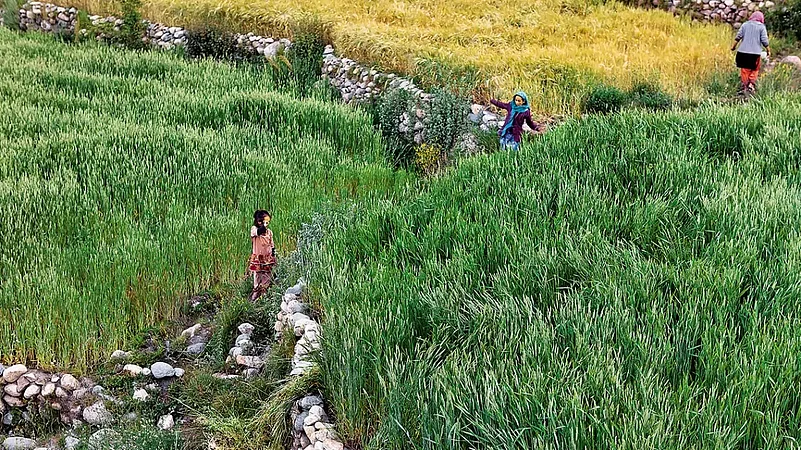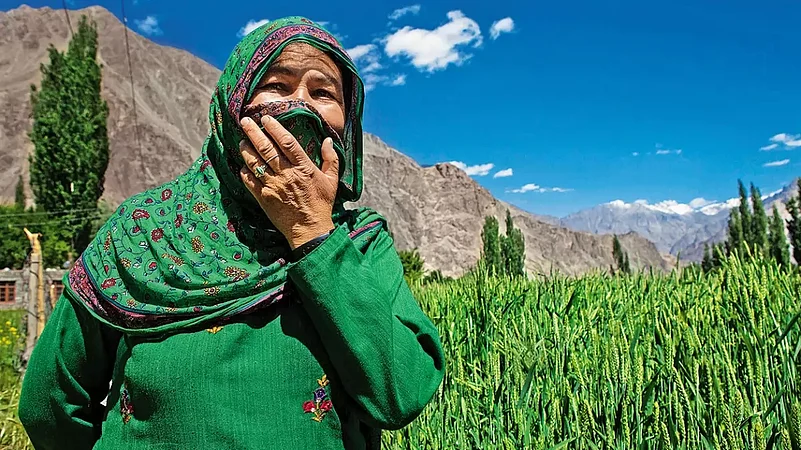As Karma, our driver, parked the car (an Innova Crysta of which he was immensely proud), Monet’s Bridge Over a Pond of Water Lilies came alive before my eyes. A wooden bridge painted in green marks the entry point to the remote village of Turtuk, a five-and-a-half-hour drive from Hunder in Nubra Valley. The distance of 77 km took my friend, Shashikala and me through some of the most spectacular landscapes—rugged, brown and purple mountains, with the river Shyok rushing past for most of the way, hairpin bends with stunning but scary rocky overhangs and roads prone to landslides and shooting stones.
After Murgo village, Turtuk is the northernmost village in India. Our first challenge was to climb the steep stairs to reach Apricot Villa, the guest house run by the young and affable Hashmat Khan, who has a Master’s degree in Tourism Management from Banares Hindu University. The village lies at an elevation of about 8,000 ft above sea level. Even as we were huffing and puffing our way up, we couldn’t help but stare open-mouthed at the ease with which our luggage was carried up by the locals.
If there is one colour to describe the village from April to August, it is green. Vast fields of buckwheat, gyas in Balti language, and a variety of vegetables such as broccoli, cauliflower, and greens spread out as far as the eye could see, hemmed in by the magnificent mountains of the Karakoram range. Fruit orchards with apricots, apples, peaches and walnuts abound. We walked along narrow, cobbled, labyrinthine paths to the guest house to the background score of a gurgling stream that rolled over pebbles in an intricate system of canals fed by water from melting glaciers to reach the fields. This is a characteristic feature of Turtuk. So proud are its inhabitants of this system that they take great care of it. Anyone found washing clothes in the canal is charged a whopping fine of Rs 5,000.
We were told that in the winter, however, the colour of the landscape changes from green to white, with temperatures falling to as low as −25° Celsius.
This timeless space, located in the southern Chorbat section of Shyok Valley, has a chequered history. Bogdang, Tyakshi, Chalun-kha, Thang and Turtuk (the largest of them) are the five Balti villages in India. Baltistan is a region that is controlled by Pakistan. During the Indo-Pak War of 1947-48, the Gilgit Scouts defeated the Dogra administration and then invaded the region of Baltistan. At the end of the war, Pakistan captured Turtuk along with a large part of Baltistan. However, during the Indo-Pak war of 1971, the Indian army captured the village. Brigadier Udai Singh and Major Chewang Rinchen, his second-in-command, entered the village after the retreat of Pakistani forces. How must it feel to sleep in one country and wake up in another without leaving your bed? This is how suddenly it happened. Once part of Pakistan, today Turtuk supplies grains and other essentials on horseback to Indian soldiers at the Siachen outpost. “Makes economic sense,” is Khan’s pragmatic remark. In fact, the village, with a population of 3,371 according to the 2011 Census, has soldiers who once belonged to the Pakistan army. During the Kargil war, some were even apprehended by the police as suspected spies, only to be acquitted by the courts later. Such is the precariousness of life in border regions.

Turtuk has a 100 percent Muslim population. Islam in Turtuk may be traced back to the 13th century, when Mir Sayid Ali Hamadani, the Iranian poet, scholar and Sufi saint of the Kubrawiya order, arrived in Baltistan. He travelled through Central Asia to Kashmir, preaching Islam. Before that, it was Buddhism that was the dominant religion. However, Bon, an ancient religious tradition, continues to colour the practice of Islam in the region. The care of the canals mentioned above is a case in point. Bon religion predates Buddhism and preaches an animistic form of worship wherein mountains, rivers, trees and forests are held sacred. As Khan poignantly said, “The whims of the weather are our enemy, not people.” In the ethos of hate that we currently live in, this seemed like a ray of hope.
It is characteristic to go ‘sightseeing’ while visiting a new place. But what is ‘sightseeing’ in Turtuk, when even looking out of your window there is a sight to behold: verdant fields with mountains all around, a gurgling stream and the patter of children walking through the narrow alleyways to their school. A walk with Khan along rambling stone paths that climbed and curved, took us to one of the most unique things to see in Turtuk: their ancient storage system. We almost jumped out of our skin when Khan showed us 15-year-old yak butter stored in a case covered with lamb skin and put into a massive trunk. Several stone bunkers built ages ago can be found here. Called nangchung in Balti language, the system is designed with gaps in the bunkers that lets cold air pass through to create an ingenious refrigeration system.
Turtuk was opened to tourists as late as 2010. One can see the rush to build homestays and guest houses to cater to the growing tourist market. Although Turtuk is not on most conducted tour itineraries yet, more and more travellers like us do find their way to this enchanted place. Concrete buildings stick out like eye sores in the midst of traditional stone structures.
The Balti Heritage House is preserved as if it were a museum and is open to tourists precisely for the fear that such structures may at some point simply vanish. The structure once belonged to Mohammed Ali Ashoor whose children were later inspired to convert it into a museum. Built more than a century ago, the house was constructed with a keen awareness of the climatic conditions of the place. The kitchen is central to Balti living. In winters, the family gathers around the fire, eating and conversing. A tiny, enclosed space in one corner, far from the fire, is reserved for infants in the house, if any. The space is enclosed on three sides, leaving one side open to hear the baby cry and allow an adult to enter. The doors are placed extremely low and much to Khan’s chagrin, I ended up hitting my head three times despite bending my entire torso! Objects of daily use filled the rooms of the house. A stone dish, for example, is 300 years old. Thick coats of yak wool, copper samovars (metal containers traditionally used to heat water), farming tools made of ibex horn and indigenous weighing scales for the kitchen were some of the fascinating items on display. Domestic animals are an integral part of homes in Turtuk. We opened the door to a room on the lower-most level to be startled by a cow eager to come out. A family of cats had made a corner of one of the rooms their home; the kittens shuddered in fear every time a visitor entered their territory.
Down the road from the heritage house is the Royal Palace. Several dynasties ruled over this region of which Yabgo Mohammad Khan Kacho, one of the survivors of the Yabgo dynasty, maintains the place with his family members. And yes, he liked to think of himself as the king of Turtuk and so did its inhabitants. The central courtyard open to the sky is reminiscent of structures in several parts of India. The palace also houses memorabilia of the royal family. Unlike the sprawling palaces of Rajasthan, this one is more like a large home. The wooden staircases, rafters on the ceilings and low doors have all stood the test of time.
Laughter abounds in Turtuk. Old men, who according to Khan, are descendants of Chengiz Khan, sit in groups, not in a circle but in a single row, side-by-side on stone benches, talking and laughing raucously. Here, everyone knows everyone. They stop Khan to enquire where we had come from and then they all laugh heartily. I wondered if it had anything to do with us. Spotting the cell phones in our hands, they told us firmly, ‘No photos!’ Even as I reassured them that I would respect their wishes, I secretly hoped they had allowed me to click a few pictures.
For dinner that evening, we had Ladakhi dishes lovingly cooked by Khan’s mother and sister-in-law. The food was mildly flavoured, retaining the taste of vegetables without dunking them in oil and spices. On the menu were buckwheat pancakes called kisir, served with tangthur, a yoghurt dip with boiled and finely chopped arctic root leaves and garnished with fried onions. Balay, a soup with boiled local pasta and aromatic herbs, was also served.
The next morning we began our descent to cross ‘Monet’s bridge’ once again; only the mood was less euphoric and more contemplative. The instability and meaninglessness of borders and the pain of separation experienced by people lay heavy on our hearts. I could not get over the story of the woman who had once left her babies in a field to fetch milk for them from her house. On her return, guarding the freshly drawn border were soldiers who stopped her from reaching her babies. Even the twenty-something Khan lets out an empty laugh that clearly doesn’t reach his eyes when he recounts the story of his uncle meeting his relatives on the other side after several decades. That pain is his inheritance imposed on him by the space called a nation that fetishises territory.
As we descend, there is a bright sun in the azure sky—the chill reaches our bones. We see women weeding their fields, children scurrying to schools, and men carrying cement sacs uphill.
It’s just another day in Turtuk.
(This appeared in the print edition as "Living on THE EDGE")
(Views expressed are personal)
Gita Viswanath is a baroda-based writer of fiction, non-fiction and poetry
















